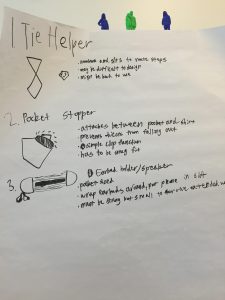Problem Recognition
Our attention for the week shifted from acclimating ourselves to the design software to analyzing problems encountered in everyday life. In order to do this, we analyzed problems from the perspective of proximity, scope, and practicality. Problems we looked at were local, narrow and specific in scope, and able to be resolved using realistic means. Once we chose our respective issues, we diagnosed responses through the lens of, “How can we…” or “How may we…”. These questions came in the form of improving an already existing product, removing the bad in something, changing the status quo, questioning assumptions, and so forth. After enduring the process, our team came up with three individual problems that we hope to resolve as part of our semester project. The first problem is one that many college students can relate to: struggling to tie a tie. The second also deals with active students, as objects can easily fall out of pants and coat pockets. Finally, our last problem was a lack of portable music optionality. Our ideating poster is shown below.

In addition, Mike Bohlman, the Assistant Dean of Technology at the College of Media, spoke to us about the various maker projects he has embarked on in order to solve everyday problems that he encounters. He touched on three projects in particular: first, there was the airplane radio he designed, then the litter box that notified him when it needed to be cleaned, and finally a smart board game that allowed for reusability while still keeping the consistency in tact. His presentation, along with the two articles “Ten Ways to Evaluate a New Business Idea” and “Creative Sparks”, gave us great inspiration for the rest of the semester, and I look forward to improving on the ideas we have already generated.
Food for Thought
One outside article I found to be particularly interesting was one titled “Dubai: DEWA Innovation Center to Offer Education in 3D Printing & More for the Disabled”, in which a radical initiative by the Dubai government aims to encourage 3D printing. Already, 150 students are enrolled in a program to teach them advanced technologies, such as robotics and 3D printing. This program specifically targets disable students, as learning these technologies, where manual labor is at a minimum, will propel them ahead in the job market.
Another article, titled “3D Food-Printing Developed in Cambridge”, is one that strongly resonated with me. As a self-proclaimed “foodie”, I enjoy food, but not the hassle of going to the grocery store. This Cambridge-based company, Dovetail, developed a 3D printer that utilizes pre-packaged liquids and certain forms of raw ingredients to produce food, and can print food on demand from a smartphone. While I would enjoy this for selfish reasons, scientists also believe it could be one avenue in which to curb the global food problem. Very exciting!
“3D Food-printing Developed in Cambridge.” BBC News. BBC, 13 Feb. 2017. Web. 27 Feb. 2017.
Millsaps, Bridget Butler. “Dubai: DEWA Innovation Center to Offer Education in 3D Printing & More for the Disabled.” 3DPrint.com. N.p., 24 Feb. 2017. Web. 26 Feb. 2017.


Hey Chase,
I think that the how can we statements that your group came up with are useful and simple problems that can be addressed. You also did a great job summarizing the article. Using questions to challenge the users thought process is very interactive. I checked those resources from Forbes and Entrepreneur, and hope to employ them with the new method we learnt in class. Other resources to learn more about this is also Edward de Bono’s article ‘Creativity is easier when it’s structured’. Good luck making progress on your project. Also you should check out Mike Bohlman’s website for all his projects at protomaker.io I found them very interesting and look forward to working on my own projects in the future.
Hey Chase, great post! Like you mentioned, I think questions like “How can we…” or “How may we…” really allow us to think deeper into the purpose of our semester projects and make our ideas more sustainable. Also, as a foodie myself as well, I think your article on 3D food-printing is really interesting and exciting! I can imagine it being pretty convenient for a quick meal, but I’m also interested in how this can potentially solve global food crisis such as lowering costs and provide nutritious meals.
Hi Chase,
I really enjoyed reading your post! I especially enjoyed your article about 3D foot printing! I had never considered the ability to create with edible materials. With the GMO controversy at the forefront of the food industry, I wonder if this new technology will permit the creation of “superfoods” and other options offering increased nutritional value without the environmental and physical downsides associated with growing these. Furthermore, I wonder if this would present a fiscally possible solution to the world hunger crisis, in making nutritious foods available at a cheaper price and larger scale. Very interesting prospects! Check out this article for further reading: http://www.popularmechanics.com/home/food-drink/a24493/3d-printed-food/